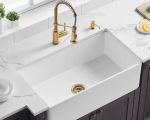How to Install a New Range Hood in the Kitchen
Installing a new range hood in your kitchen can improve both the air quality and aesthetics of your cooking space. Whether you're replacing an old unit or adding one to your kitchen for the first time, the process is straightforward if you follow the right steps. In this article, I'll guide you through everything you need to know about how to install a range hood in your kitchen—from choosing the right one to the tools and steps needed to get it installed correctly. Let’s dive in!
1. Choose the Right Range Hood for Your Kitchen
Before diving into the installation process, it’s important to pick the right range hood for your kitchen’s size and cooking style. A range hood is an essential kitchen appliance that helps to vent out smoke, steam, and odors produced while cooking, so choosing the right one can significantly impact your cooking experience. There are several types of range hoods available, and each has its own set of benefits:
1.1 Wall-Mounted Range Hoods
If you have a kitchen with a wall directly above your stove, a wall-mounted range hood is the best choice. These hoods are installed directly to the wall above the cooking area and offer efficient air circulation. They are sleek, modern, and can provide substantial ventilation power, which is perfect for larger kitchens.
1.2 Under-Cabinet Range Hoods
Under-cabinet range hoods are designed to be mounted underneath your kitchen cabinets. They are ideal if you're looking to save space and keep a streamlined look. These are often less intrusive than wall-mounted models and work well in smaller kitchens or those with limited wall space.
1.3 Island Range Hoods
For kitchens with an island stove or cooking area, an island range hood is a great option. These hoods are mounted to the ceiling above the stove, making them perfect for central cooking spaces. They are stylish and efficient, offering great performance while keeping the kitchen air clean and fresh.
2. Gather Your Tools and Materials
Once you’ve chosen the range hood that fits your kitchen, it’s time to prepare for the installation. Having the right tools on hand will make the process smoother and faster. Here's a list of materials and tools you’ll need:
- Range hood unit
- Power drill with appropriate drill bits
- Screwdriver
- Measuring tape
- Level
- Electrical wiring and connections (if needed)
- Venting ducts and adapters (if needed)
- Stud finder (for wall-mounted installations)
- Safety goggles and gloves
Make sure you have everything you need before starting to ensure a smooth process. Having your tools ready will help you stay focused and reduce interruptions.
3. Prepare the Installation Area
Before you start installing the range hood, it’s important to properly prepare the area where the unit will go. This includes clearing the space around the stove and ensuring that the electrical wiring and ventilation system are in good shape. If you’re replacing an old unit, carefully remove the old range hood and check for any damage or areas that need repairs. If you're adding a range hood to a kitchen without one, make sure you have the proper ventilation system in place (either ducted or ductless).
3.1 Check for Power Supply
If your new range hood requires an electrical connection, make sure you have access to a power supply near the installation area. For most installations, you may need to hire an electrician to ensure the wiring meets local safety codes. This is especially important if your new range hood requires hardwiring rather than simply plugging into an outlet.
3.2 Ensure Proper Ventilation
If you’re installing a ducted range hood, ensure that there’s an exhaust vent in the kitchen, ideally leading outside. If there’s no existing ductwork, you may need to cut a hole in the wall or ceiling for the vent. This is a task that may require some advanced skills, and it's always better to consult a professional if you're unsure about how to proceed.
4. Install the Range Hood Unit
With the area prepared and the tools in hand, you’re ready to start installing the range hood. Depending on the model you've chosen, the installation steps may vary slightly. However, the general process for most range hoods remains the same:
4.1 Mount the Brackets
Start by mounting the range hood's support brackets to the wall or ceiling. Use a level to ensure that the brackets are straight, as this will prevent your range hood from hanging unevenly. For wall-mounted hoods, use a stud finder to locate the studs in the wall, as these provide the most stable support. Secure the brackets with screws, making sure they’re tightly fastened to the studs.
4.2 Install the Range Hood Unit
Once the brackets are in place, carefully lift the range hood onto the mounted brackets. Secure the range hood by screwing it into place, ensuring that it’s flush with the wall or ceiling. Take your time to adjust the unit and ensure it’s properly aligned before tightening the screws fully.
4.3 Connect the Ductwork (If Applicable)
If you’re installing a ducted range hood, the next step is to connect the ductwork. Attach the vent pipe from the range hood to the ductwork that leads outside. Secure the connection with clamps or tape, making sure there are no leaks. Ductless models will require a carbon filter installation, which can be placed inside the unit to purify the air before recirculating it back into the kitchen.
5. Make the Electrical Connections
If your range hood is electric and requires hardwiring, this step is crucial. Ensure the power is turned off before proceeding with any electrical work. If you're not familiar with electrical systems, it’s highly recommended to hire a professional electrician. Once the wiring is complete, turn the power back on and test the unit to make sure it’s functioning properly.
6. Test and Final Adjustments
After completing the installation, it’s time to test the range hood. Turn it on and check for proper airflow and noise levels. Make sure the fan operates smoothly and there’s no obstruction in the venting system. If you notice any issues, check for loose connections or misalignment. Adjust the settings on your range hood to your desired speed and settings.
If everything works as expected, congratulations! You’ve successfully installed a new range hood in your kitchen.
For additional help and expert recommendations on the best range hoods for your needs, visit Improvement for top-rated products and professional installation services that will make your kitchen safer and more efficient.
<> SEO Title: How to Install a New Range Hood in the Kitchen - Step-by-Step Guide SEO Keywords: install range hood, range hood installation, kitchen range hood, ducted range hood, kitchen ventilation, professional range hood installation SEO Description: Learn how to install a new range hood in your kitchen with this step-by-step guide. Discover tips on choosing the right range hood, preparing for installation, and ensuring everything works perfectly.







